Workplace Discrimination Impact on Employee Performance: Sainsbury's
VerifiedAdded on 2023/01/13
|29
|6118
|1
Report
AI Summary
This research report delves into the issue of workplace discrimination, focusing on its impact on employee performance, using Sainsbury's as a case study. The report begins with an introduction outlining the research proposal, objectives, and questions. It then provides a comprehensive literature review, defining workplace discrimination, exploring its causes such as retaliation, sex, and age discrimination, and examining potential solutions like written rules, complaint protocols, and education. The methodology section details the research approach, methodologies (qualitative and quantitative), research philosophy (positivism), sampling methods, data analysis techniques, and ethical considerations. The data collection and analysis chapter discusses primary and secondary data collection methods, including thematic analysis. The report concludes with a summary of findings, conclusions, and recommendations for addressing workplace discrimination and enhancing employee performance, along with a personal reflective statement. The report provides a detailed examination of workplace discrimination, offering insights into its causes, consequences, and potential solutions within the context of a major UK supermarket chain.
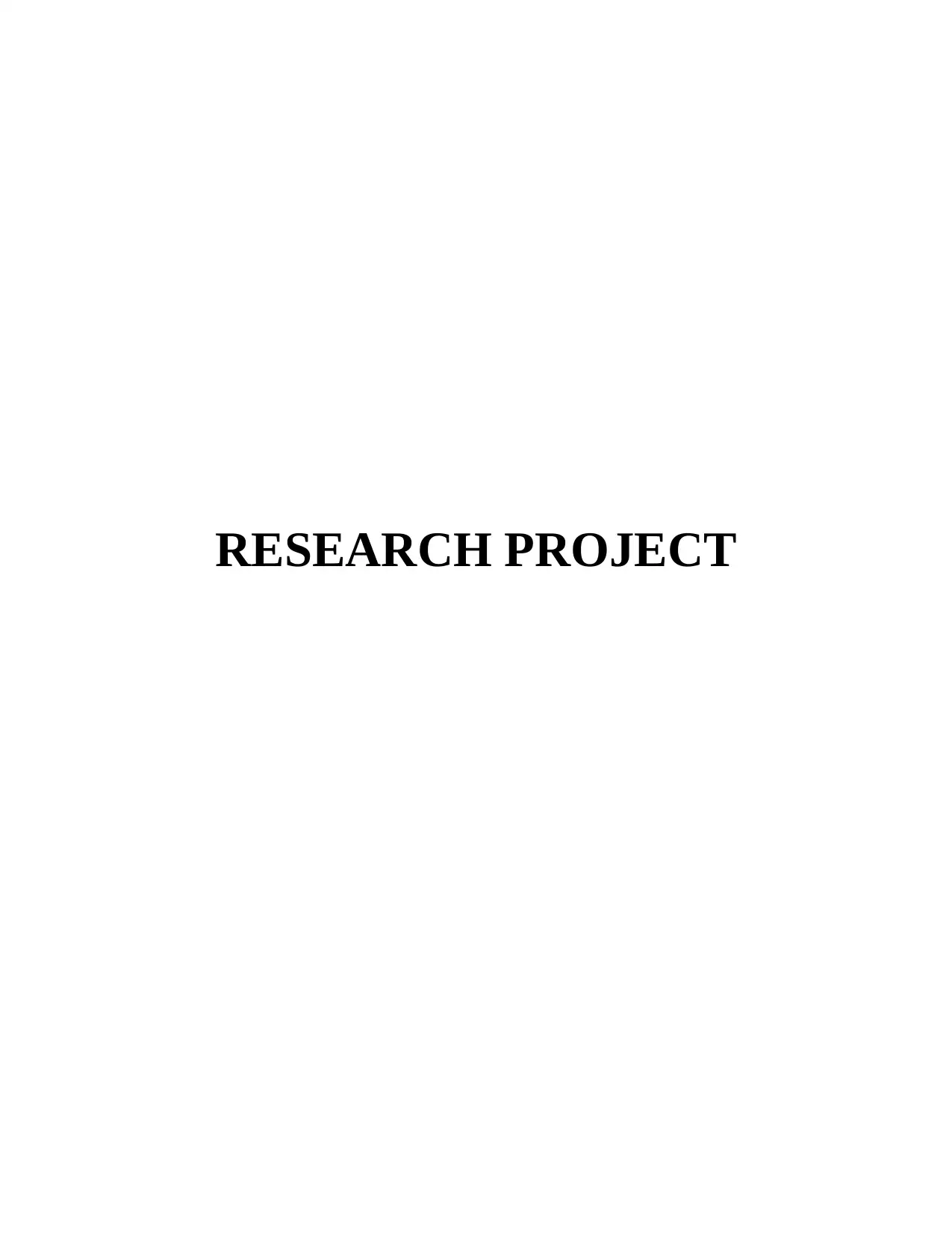
RESEARCH PROJECT
Paraphrase This Document
Need a fresh take? Get an instant paraphrase of this document with our AI Paraphraser
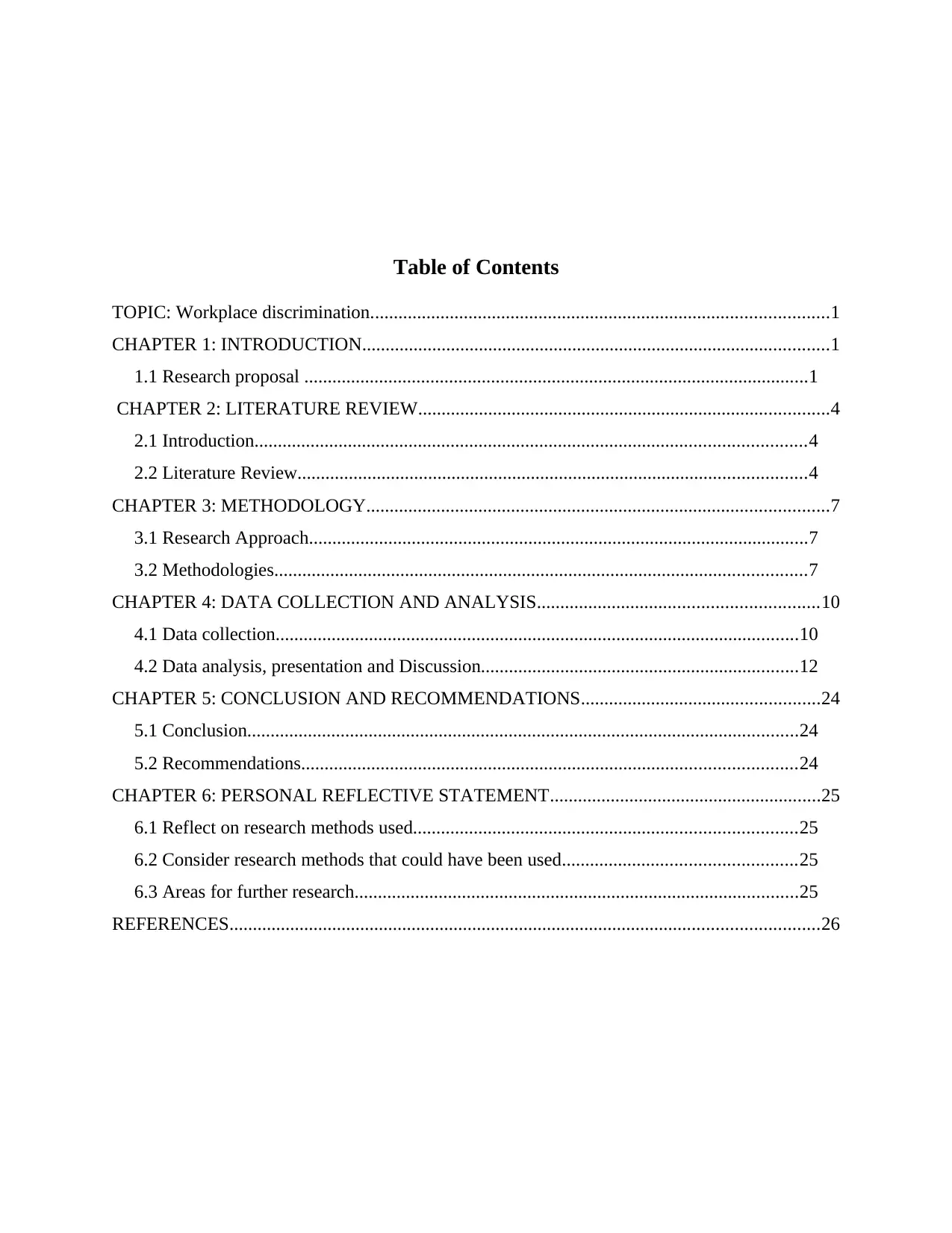
Table of Contents
TOPIC: Workplace discrimination..................................................................................................1
CHAPTER 1: INTRODUCTION....................................................................................................1
1.1 Research proposal ............................................................................................................1
CHAPTER 2: LITERATURE REVIEW........................................................................................4
2.1 Introduction......................................................................................................................4
2.2 Literature Review.............................................................................................................4
CHAPTER 3: METHODOLOGY...................................................................................................7
3.1 Research Approach...........................................................................................................7
3.2 Methodologies..................................................................................................................7
CHAPTER 4: DATA COLLECTION AND ANALYSIS............................................................10
4.1 Data collection................................................................................................................10
4.2 Data analysis, presentation and Discussion....................................................................12
CHAPTER 5: CONCLUSION AND RECOMMENDATIONS...................................................24
5.1 Conclusion......................................................................................................................24
5.2 Recommendations..........................................................................................................24
CHAPTER 6: PERSONAL REFLECTIVE STATEMENT..........................................................25
6.1 Reflect on research methods used..................................................................................25
6.2 Consider research methods that could have been used..................................................25
6.3 Areas for further research...............................................................................................25
REFERENCES..............................................................................................................................26
TOPIC: Workplace discrimination..................................................................................................1
CHAPTER 1: INTRODUCTION....................................................................................................1
1.1 Research proposal ............................................................................................................1
CHAPTER 2: LITERATURE REVIEW........................................................................................4
2.1 Introduction......................................................................................................................4
2.2 Literature Review.............................................................................................................4
CHAPTER 3: METHODOLOGY...................................................................................................7
3.1 Research Approach...........................................................................................................7
3.2 Methodologies..................................................................................................................7
CHAPTER 4: DATA COLLECTION AND ANALYSIS............................................................10
4.1 Data collection................................................................................................................10
4.2 Data analysis, presentation and Discussion....................................................................12
CHAPTER 5: CONCLUSION AND RECOMMENDATIONS...................................................24
5.1 Conclusion......................................................................................................................24
5.2 Recommendations..........................................................................................................24
CHAPTER 6: PERSONAL REFLECTIVE STATEMENT..........................................................25
6.1 Reflect on research methods used..................................................................................25
6.2 Consider research methods that could have been used..................................................25
6.3 Areas for further research...............................................................................................25
REFERENCES..............................................................................................................................26
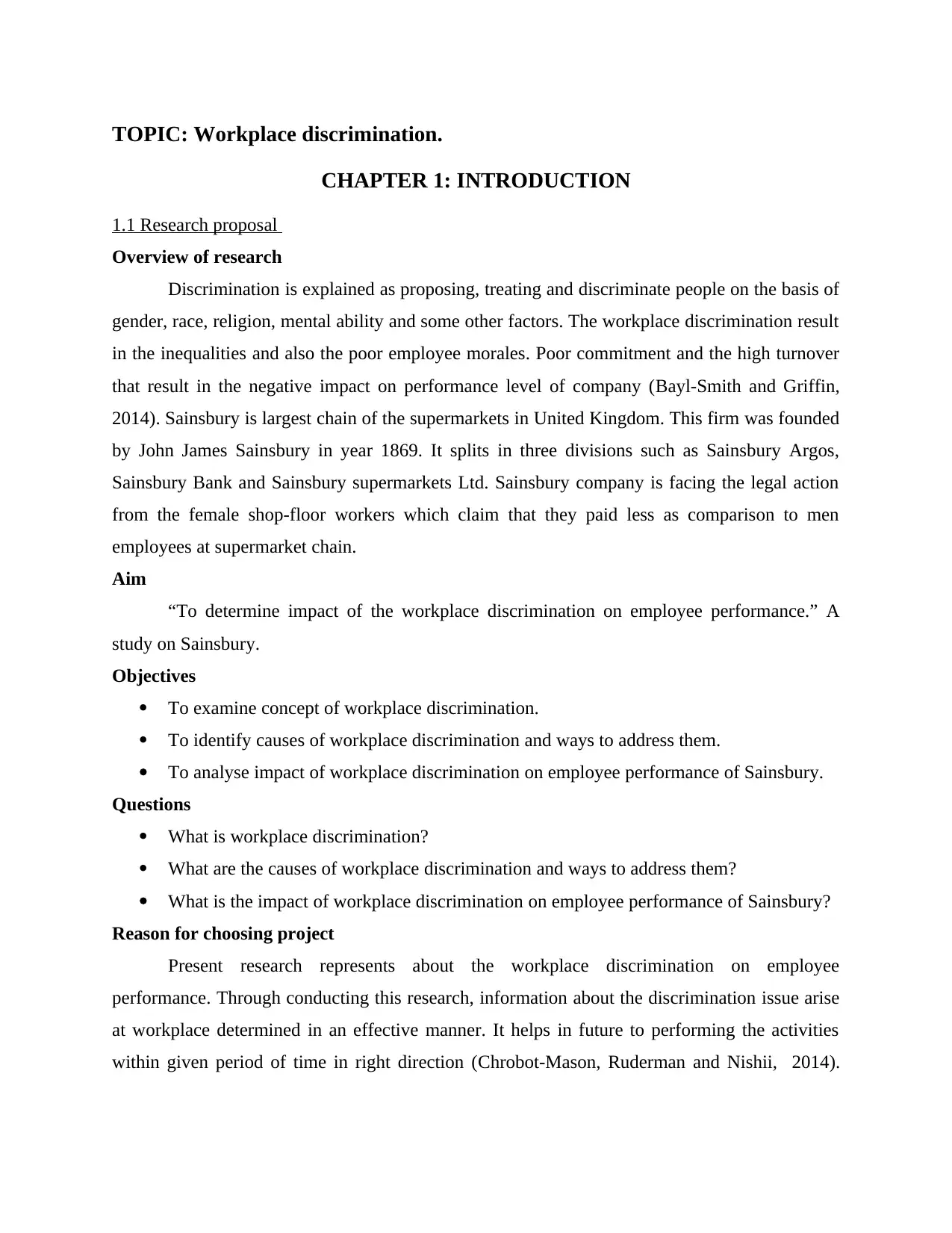
TOPIC: Workplace discrimination.
CHAPTER 1: INTRODUCTION
1.1 Research proposal
Overview of research
Discrimination is explained as proposing, treating and discriminate people on the basis of
gender, race, religion, mental ability and some other factors. The workplace discrimination result
in the inequalities and also the poor employee morales. Poor commitment and the high turnover
that result in the negative impact on performance level of company (Bayl‐Smith and Griffin,
2014). Sainsbury is largest chain of the supermarkets in United Kingdom. This firm was founded
by John James Sainsbury in year 1869. It splits in three divisions such as Sainsbury Argos,
Sainsbury Bank and Sainsbury supermarkets Ltd. Sainsbury company is facing the legal action
from the female shop-floor workers which claim that they paid less as comparison to men
employees at supermarket chain.
Aim
“To determine impact of the workplace discrimination on employee performance.” A
study on Sainsbury.
Objectives
To examine concept of workplace discrimination.
To identify causes of workplace discrimination and ways to address them.
To analyse impact of workplace discrimination on employee performance of Sainsbury.
Questions
What is workplace discrimination?
What are the causes of workplace discrimination and ways to address them?
What is the impact of workplace discrimination on employee performance of Sainsbury?
Reason for choosing project
Present research represents about the workplace discrimination on employee
performance. Through conducting this research, information about the discrimination issue arise
at workplace determined in an effective manner. It helps in future to performing the activities
within given period of time in right direction (Chrobot-Mason, Ruderman and Nishii, 2014).
CHAPTER 1: INTRODUCTION
1.1 Research proposal
Overview of research
Discrimination is explained as proposing, treating and discriminate people on the basis of
gender, race, religion, mental ability and some other factors. The workplace discrimination result
in the inequalities and also the poor employee morales. Poor commitment and the high turnover
that result in the negative impact on performance level of company (Bayl‐Smith and Griffin,
2014). Sainsbury is largest chain of the supermarkets in United Kingdom. This firm was founded
by John James Sainsbury in year 1869. It splits in three divisions such as Sainsbury Argos,
Sainsbury Bank and Sainsbury supermarkets Ltd. Sainsbury company is facing the legal action
from the female shop-floor workers which claim that they paid less as comparison to men
employees at supermarket chain.
Aim
“To determine impact of the workplace discrimination on employee performance.” A
study on Sainsbury.
Objectives
To examine concept of workplace discrimination.
To identify causes of workplace discrimination and ways to address them.
To analyse impact of workplace discrimination on employee performance of Sainsbury.
Questions
What is workplace discrimination?
What are the causes of workplace discrimination and ways to address them?
What is the impact of workplace discrimination on employee performance of Sainsbury?
Reason for choosing project
Present research represents about the workplace discrimination on employee
performance. Through conducting this research, information about the discrimination issue arise
at workplace determined in an effective manner. It helps in future to performing the activities
within given period of time in right direction (Chrobot-Mason, Ruderman and Nishii, 2014).
⊘ This is a preview!⊘
Do you want full access?
Subscribe today to unlock all pages.

Trusted by 1+ million students worldwide
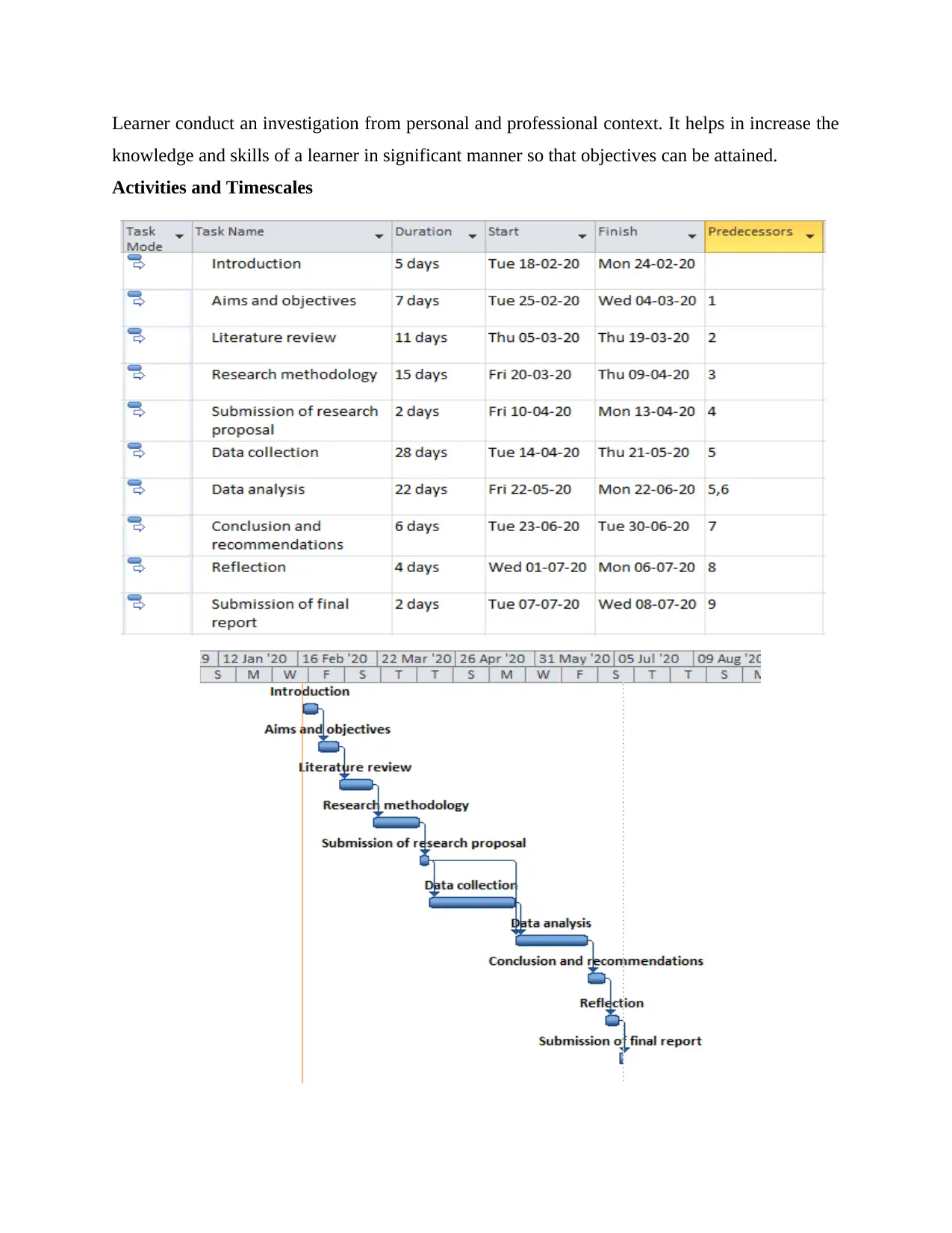
Learner conduct an investigation from personal and professional context. It helps in increase the
knowledge and skills of a learner in significant manner so that objectives can be attained.
Activities and Timescales
knowledge and skills of a learner in significant manner so that objectives can be attained.
Activities and Timescales
Paraphrase This Document
Need a fresh take? Get an instant paraphrase of this document with our AI Paraphraser

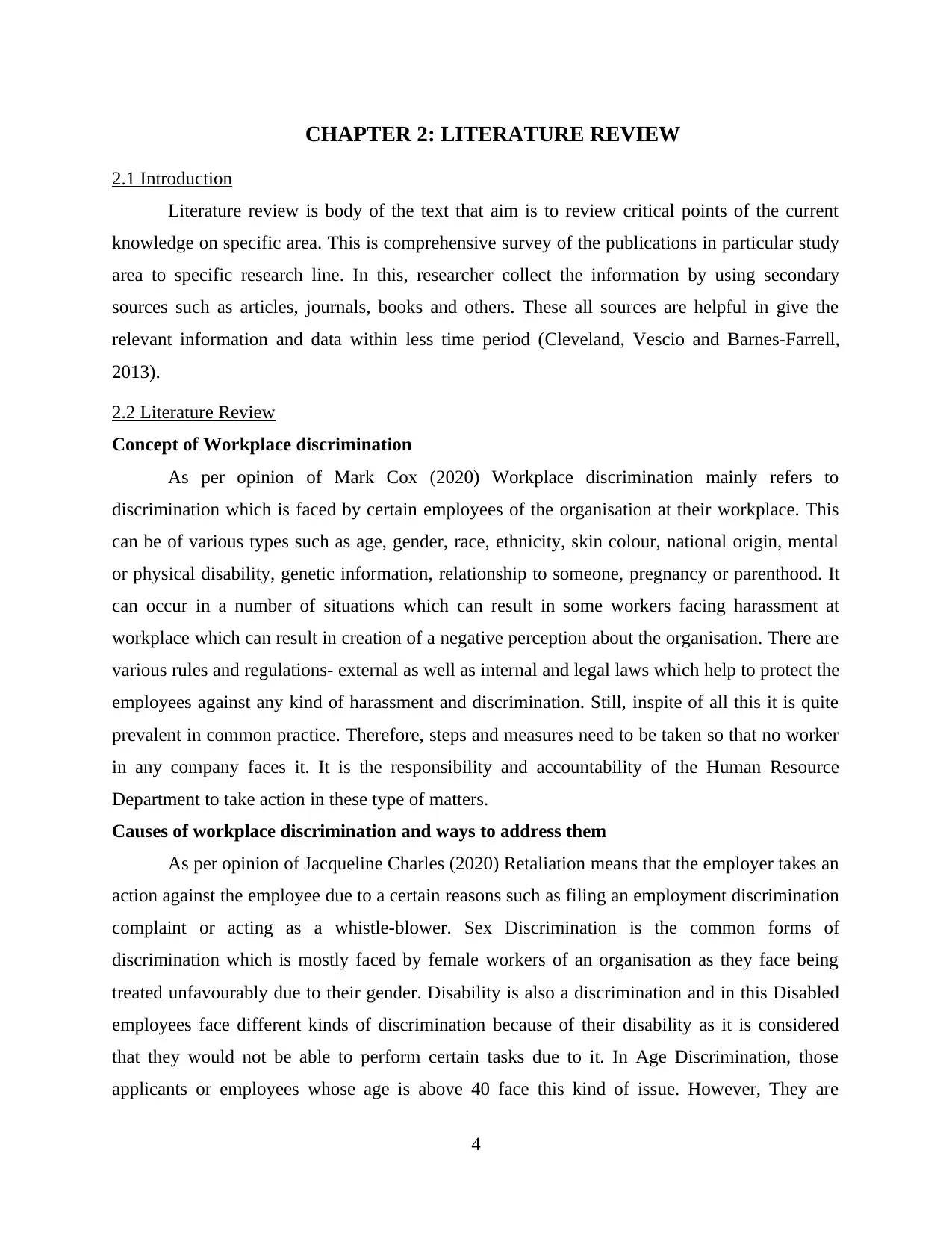
CHAPTER 2: LITERATURE REVIEW
2.1 Introduction
Literature review is body of the text that aim is to review critical points of the current
knowledge on specific area. This is comprehensive survey of the publications in particular study
area to specific research line. In this, researcher collect the information by using secondary
sources such as articles, journals, books and others. These all sources are helpful in give the
relevant information and data within less time period (Cleveland, Vescio and Barnes-Farrell,
2013).
2.2 Literature Review
Concept of Workplace discrimination
As per opinion of Mark Cox (2020) Workplace discrimination mainly refers to
discrimination which is faced by certain employees of the organisation at their workplace. This
can be of various types such as age, gender, race, ethnicity, skin colour, national origin, mental
or physical disability, genetic information, relationship to someone, pregnancy or parenthood. It
can occur in a number of situations which can result in some workers facing harassment at
workplace which can result in creation of a negative perception about the organisation. There are
various rules and regulations- external as well as internal and legal laws which help to protect the
employees against any kind of harassment and discrimination. Still, inspite of all this it is quite
prevalent in common practice. Therefore, steps and measures need to be taken so that no worker
in any company faces it. It is the responsibility and accountability of the Human Resource
Department to take action in these type of matters.
Causes of workplace discrimination and ways to address them
As per opinion of Jacqueline Charles (2020) Retaliation means that the employer takes an
action against the employee due to a certain reasons such as filing an employment discrimination
complaint or acting as a whistle-blower. Sex Discrimination is the common forms of
discrimination which is mostly faced by female workers of an organisation as they face being
treated unfavourably due to their gender. Disability is also a discrimination and in this Disabled
employees face different kinds of discrimination because of their disability as it is considered
that they would not be able to perform certain tasks due to it. In Age Discrimination, those
applicants or employees whose age is above 40 face this kind of issue. However, They are
4
2.1 Introduction
Literature review is body of the text that aim is to review critical points of the current
knowledge on specific area. This is comprehensive survey of the publications in particular study
area to specific research line. In this, researcher collect the information by using secondary
sources such as articles, journals, books and others. These all sources are helpful in give the
relevant information and data within less time period (Cleveland, Vescio and Barnes-Farrell,
2013).
2.2 Literature Review
Concept of Workplace discrimination
As per opinion of Mark Cox (2020) Workplace discrimination mainly refers to
discrimination which is faced by certain employees of the organisation at their workplace. This
can be of various types such as age, gender, race, ethnicity, skin colour, national origin, mental
or physical disability, genetic information, relationship to someone, pregnancy or parenthood. It
can occur in a number of situations which can result in some workers facing harassment at
workplace which can result in creation of a negative perception about the organisation. There are
various rules and regulations- external as well as internal and legal laws which help to protect the
employees against any kind of harassment and discrimination. Still, inspite of all this it is quite
prevalent in common practice. Therefore, steps and measures need to be taken so that no worker
in any company faces it. It is the responsibility and accountability of the Human Resource
Department to take action in these type of matters.
Causes of workplace discrimination and ways to address them
As per opinion of Jacqueline Charles (2020) Retaliation means that the employer takes an
action against the employee due to a certain reasons such as filing an employment discrimination
complaint or acting as a whistle-blower. Sex Discrimination is the common forms of
discrimination which is mostly faced by female workers of an organisation as they face being
treated unfavourably due to their gender. Disability is also a discrimination and in this Disabled
employees face different kinds of discrimination because of their disability as it is considered
that they would not be able to perform certain tasks due to it. In Age Discrimination, those
applicants or employees whose age is above 40 face this kind of issue. However, They are
4
⊘ This is a preview!⊘
Do you want full access?
Subscribe today to unlock all pages.

Trusted by 1+ million students worldwide
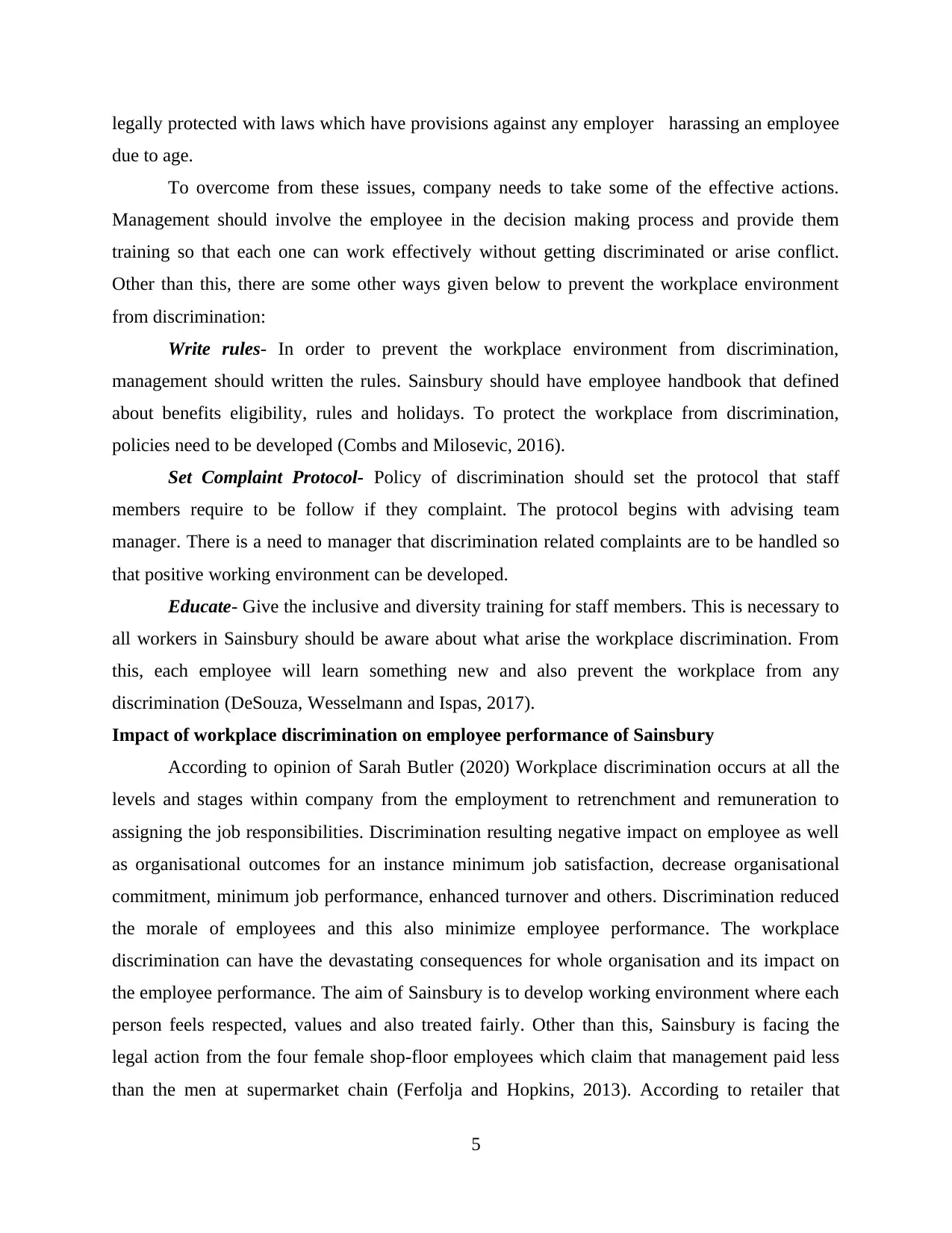
legally protected with laws which have provisions against any employer harassing an employee
due to age.
To overcome from these issues, company needs to take some of the effective actions.
Management should involve the employee in the decision making process and provide them
training so that each one can work effectively without getting discriminated or arise conflict.
Other than this, there are some other ways given below to prevent the workplace environment
from discrimination:
Write rules- In order to prevent the workplace environment from discrimination,
management should written the rules. Sainsbury should have employee handbook that defined
about benefits eligibility, rules and holidays. To protect the workplace from discrimination,
policies need to be developed (Combs and Milosevic, 2016).
Set Complaint Protocol- Policy of discrimination should set the protocol that staff
members require to be follow if they complaint. The protocol begins with advising team
manager. There is a need to manager that discrimination related complaints are to be handled so
that positive working environment can be developed.
Educate- Give the inclusive and diversity training for staff members. This is necessary to
all workers in Sainsbury should be aware about what arise the workplace discrimination. From
this, each employee will learn something new and also prevent the workplace from any
discrimination (DeSouza, Wesselmann and Ispas, 2017).
Impact of workplace discrimination on employee performance of Sainsbury
According to opinion of Sarah Butler (2020) Workplace discrimination occurs at all the
levels and stages within company from the employment to retrenchment and remuneration to
assigning the job responsibilities. Discrimination resulting negative impact on employee as well
as organisational outcomes for an instance minimum job satisfaction, decrease organisational
commitment, minimum job performance, enhanced turnover and others. Discrimination reduced
the morale of employees and this also minimize employee performance. The workplace
discrimination can have the devastating consequences for whole organisation and its impact on
the employee performance. The aim of Sainsbury is to develop working environment where each
person feels respected, values and also treated fairly. Other than this, Sainsbury is facing the
legal action from the four female shop-floor employees which claim that management paid less
than the men at supermarket chain (Ferfolja and Hopkins, 2013). According to retailer that
5
due to age.
To overcome from these issues, company needs to take some of the effective actions.
Management should involve the employee in the decision making process and provide them
training so that each one can work effectively without getting discriminated or arise conflict.
Other than this, there are some other ways given below to prevent the workplace environment
from discrimination:
Write rules- In order to prevent the workplace environment from discrimination,
management should written the rules. Sainsbury should have employee handbook that defined
about benefits eligibility, rules and holidays. To protect the workplace from discrimination,
policies need to be developed (Combs and Milosevic, 2016).
Set Complaint Protocol- Policy of discrimination should set the protocol that staff
members require to be follow if they complaint. The protocol begins with advising team
manager. There is a need to manager that discrimination related complaints are to be handled so
that positive working environment can be developed.
Educate- Give the inclusive and diversity training for staff members. This is necessary to
all workers in Sainsbury should be aware about what arise the workplace discrimination. From
this, each employee will learn something new and also prevent the workplace from any
discrimination (DeSouza, Wesselmann and Ispas, 2017).
Impact of workplace discrimination on employee performance of Sainsbury
According to opinion of Sarah Butler (2020) Workplace discrimination occurs at all the
levels and stages within company from the employment to retrenchment and remuneration to
assigning the job responsibilities. Discrimination resulting negative impact on employee as well
as organisational outcomes for an instance minimum job satisfaction, decrease organisational
commitment, minimum job performance, enhanced turnover and others. Discrimination reduced
the morale of employees and this also minimize employee performance. The workplace
discrimination can have the devastating consequences for whole organisation and its impact on
the employee performance. The aim of Sainsbury is to develop working environment where each
person feels respected, values and also treated fairly. Other than this, Sainsbury is facing the
legal action from the four female shop-floor employees which claim that management paid less
than the men at supermarket chain (Ferfolja and Hopkins, 2013). According to retailer that
5
Paraphrase This Document
Need a fresh take? Get an instant paraphrase of this document with our AI Paraphraser

higher pay for the stacking products in the warehouses is confirmed through uncomfortable
situations, unsocial working hours and the additional skills included. This kind of issue reduce
the morale of employees and also impact on their performance level at workplace.
6
situations, unsocial working hours and the additional skills included. This kind of issue reduce
the morale of employees and also impact on their performance level at workplace.
6
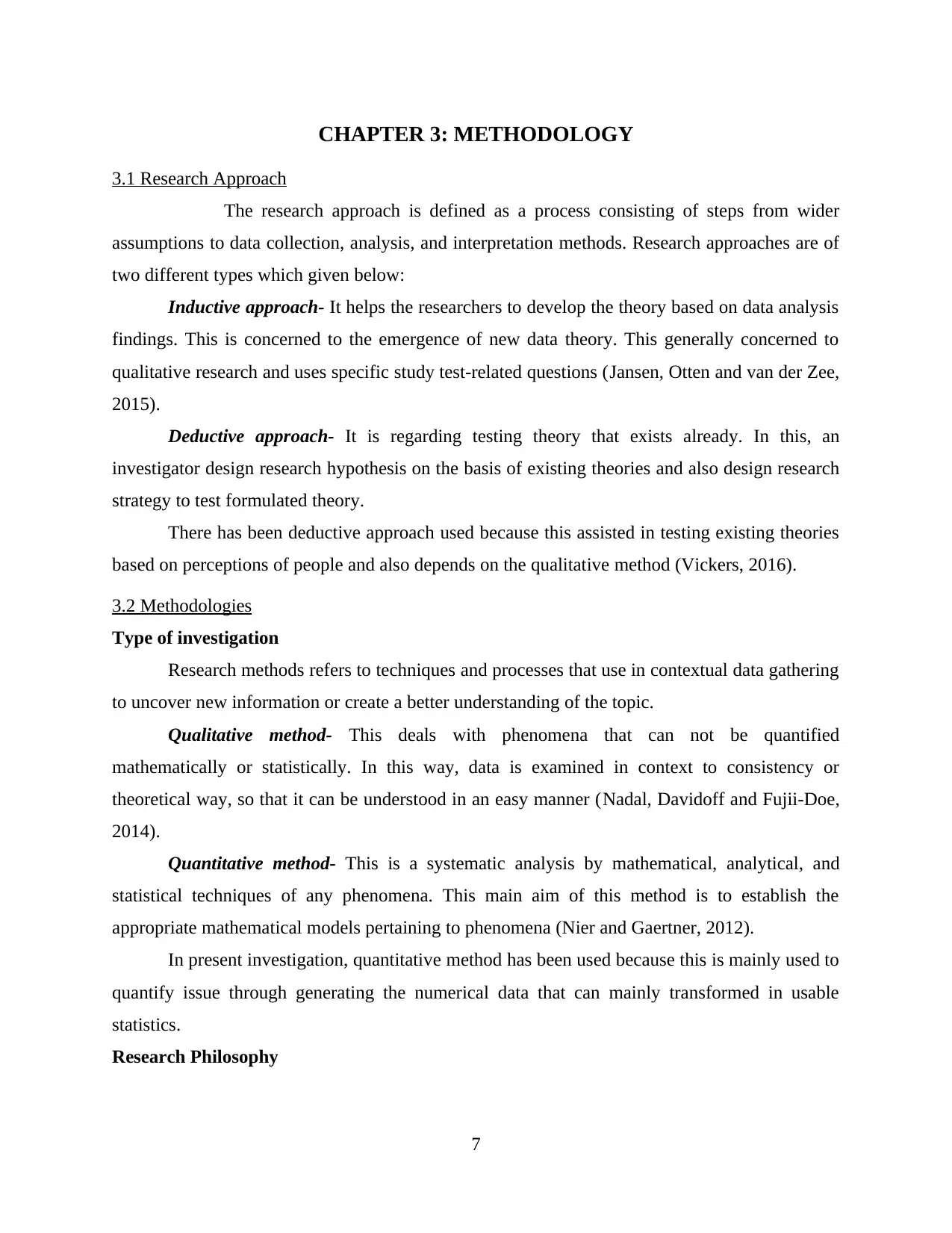
CHAPTER 3: METHODOLOGY
3.1 Research Approach
The research approach is defined as a process consisting of steps from wider
assumptions to data collection, analysis, and interpretation methods. Research approaches are of
two different types which given below:
Inductive approach- It helps the researchers to develop the theory based on data analysis
findings. This is concerned to the emergence of new data theory. This generally concerned to
qualitative research and uses specific study test-related questions (Jansen, Otten and van der Zee,
2015).
Deductive approach- It is regarding testing theory that exists already. In this, an
investigator design research hypothesis on the basis of existing theories and also design research
strategy to test formulated theory.
There has been deductive approach used because this assisted in testing existing theories
based on perceptions of people and also depends on the qualitative method (Vickers, 2016).
3.2 Methodologies
Type of investigation
Research methods refers to techniques and processes that use in contextual data gathering
to uncover new information or create a better understanding of the topic.
Qualitative method- This deals with phenomena that can not be quantified
mathematically or statistically. In this way, data is examined in context to consistency or
theoretical way, so that it can be understood in an easy manner (Nadal, Davidoff and Fujii-Doe,
2014).
Quantitative method- This is a systematic analysis by mathematical, analytical, and
statistical techniques of any phenomena. This main aim of this method is to establish the
appropriate mathematical models pertaining to phenomena (Nier and Gaertner, 2012).
In present investigation, quantitative method has been used because this is mainly used to
quantify issue through generating the numerical data that can mainly transformed in usable
statistics.
Research Philosophy
7
3.1 Research Approach
The research approach is defined as a process consisting of steps from wider
assumptions to data collection, analysis, and interpretation methods. Research approaches are of
two different types which given below:
Inductive approach- It helps the researchers to develop the theory based on data analysis
findings. This is concerned to the emergence of new data theory. This generally concerned to
qualitative research and uses specific study test-related questions (Jansen, Otten and van der Zee,
2015).
Deductive approach- It is regarding testing theory that exists already. In this, an
investigator design research hypothesis on the basis of existing theories and also design research
strategy to test formulated theory.
There has been deductive approach used because this assisted in testing existing theories
based on perceptions of people and also depends on the qualitative method (Vickers, 2016).
3.2 Methodologies
Type of investigation
Research methods refers to techniques and processes that use in contextual data gathering
to uncover new information or create a better understanding of the topic.
Qualitative method- This deals with phenomena that can not be quantified
mathematically or statistically. In this way, data is examined in context to consistency or
theoretical way, so that it can be understood in an easy manner (Nadal, Davidoff and Fujii-Doe,
2014).
Quantitative method- This is a systematic analysis by mathematical, analytical, and
statistical techniques of any phenomena. This main aim of this method is to establish the
appropriate mathematical models pertaining to phenomena (Nier and Gaertner, 2012).
In present investigation, quantitative method has been used because this is mainly used to
quantify issue through generating the numerical data that can mainly transformed in usable
statistics.
Research Philosophy
7
⊘ This is a preview!⊘
Do you want full access?
Subscribe today to unlock all pages.

Trusted by 1+ million students worldwide
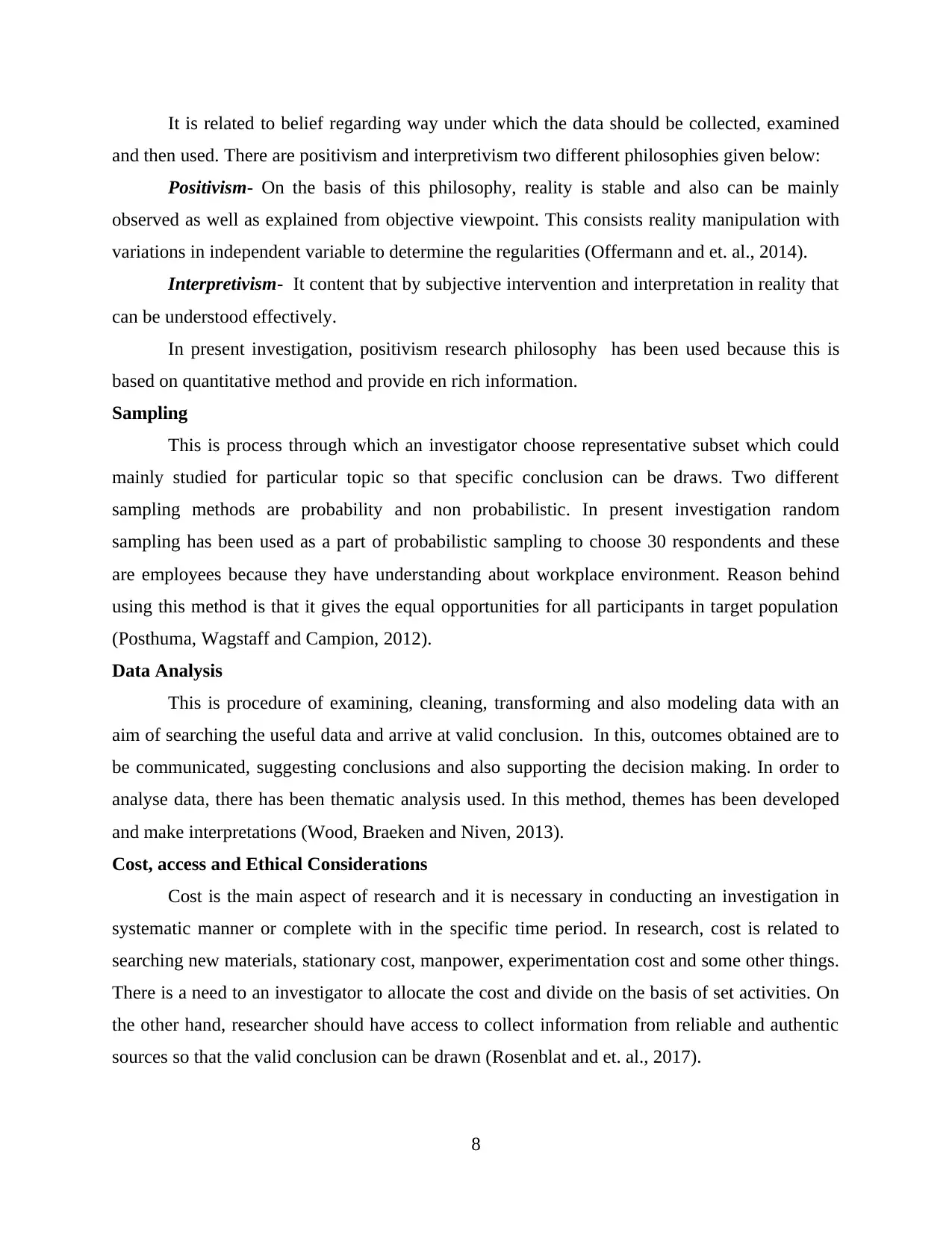
It is related to belief regarding way under which the data should be collected, examined
and then used. There are positivism and interpretivism two different philosophies given below:
Positivism- On the basis of this philosophy, reality is stable and also can be mainly
observed as well as explained from objective viewpoint. This consists reality manipulation with
variations in independent variable to determine the regularities (Offermann and et. al., 2014).
Interpretivism- It content that by subjective intervention and interpretation in reality that
can be understood effectively.
In present investigation, positivism research philosophy has been used because this is
based on quantitative method and provide en rich information.
Sampling
This is process through which an investigator choose representative subset which could
mainly studied for particular topic so that specific conclusion can be draws. Two different
sampling methods are probability and non probabilistic. In present investigation random
sampling has been used as a part of probabilistic sampling to choose 30 respondents and these
are employees because they have understanding about workplace environment. Reason behind
using this method is that it gives the equal opportunities for all participants in target population
(Posthuma, Wagstaff and Campion, 2012).
Data Analysis
This is procedure of examining, cleaning, transforming and also modeling data with an
aim of searching the useful data and arrive at valid conclusion. In this, outcomes obtained are to
be communicated, suggesting conclusions and also supporting the decision making. In order to
analyse data, there has been thematic analysis used. In this method, themes has been developed
and make interpretations (Wood, Braeken and Niven, 2013).
Cost, access and Ethical Considerations
Cost is the main aspect of research and it is necessary in conducting an investigation in
systematic manner or complete with in the specific time period. In research, cost is related to
searching new materials, stationary cost, manpower, experimentation cost and some other things.
There is a need to an investigator to allocate the cost and divide on the basis of set activities. On
the other hand, researcher should have access to collect information from reliable and authentic
sources so that the valid conclusion can be drawn (Rosenblat and et. al., 2017).
8
and then used. There are positivism and interpretivism two different philosophies given below:
Positivism- On the basis of this philosophy, reality is stable and also can be mainly
observed as well as explained from objective viewpoint. This consists reality manipulation with
variations in independent variable to determine the regularities (Offermann and et. al., 2014).
Interpretivism- It content that by subjective intervention and interpretation in reality that
can be understood effectively.
In present investigation, positivism research philosophy has been used because this is
based on quantitative method and provide en rich information.
Sampling
This is process through which an investigator choose representative subset which could
mainly studied for particular topic so that specific conclusion can be draws. Two different
sampling methods are probability and non probabilistic. In present investigation random
sampling has been used as a part of probabilistic sampling to choose 30 respondents and these
are employees because they have understanding about workplace environment. Reason behind
using this method is that it gives the equal opportunities for all participants in target population
(Posthuma, Wagstaff and Campion, 2012).
Data Analysis
This is procedure of examining, cleaning, transforming and also modeling data with an
aim of searching the useful data and arrive at valid conclusion. In this, outcomes obtained are to
be communicated, suggesting conclusions and also supporting the decision making. In order to
analyse data, there has been thematic analysis used. In this method, themes has been developed
and make interpretations (Wood, Braeken and Niven, 2013).
Cost, access and Ethical Considerations
Cost is the main aspect of research and it is necessary in conducting an investigation in
systematic manner or complete with in the specific time period. In research, cost is related to
searching new materials, stationary cost, manpower, experimentation cost and some other things.
There is a need to an investigator to allocate the cost and divide on the basis of set activities. On
the other hand, researcher should have access to collect information from reliable and authentic
sources so that the valid conclusion can be drawn (Rosenblat and et. al., 2017).
8
Paraphrase This Document
Need a fresh take? Get an instant paraphrase of this document with our AI Paraphraser
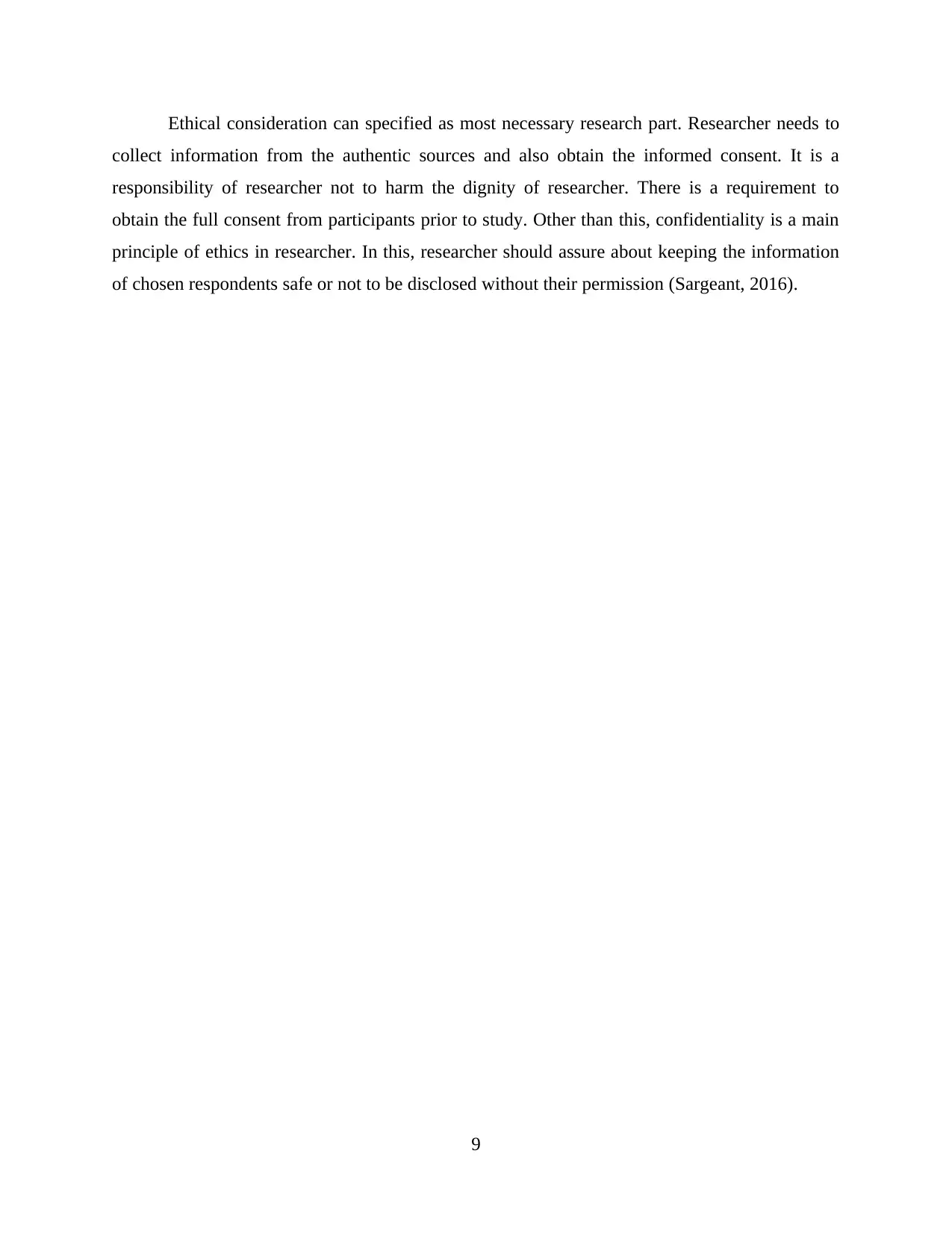
Ethical consideration can specified as most necessary research part. Researcher needs to
collect information from the authentic sources and also obtain the informed consent. It is a
responsibility of researcher not to harm the dignity of researcher. There is a requirement to
obtain the full consent from participants prior to study. Other than this, confidentiality is a main
principle of ethics in researcher. In this, researcher should assure about keeping the information
of chosen respondents safe or not to be disclosed without their permission (Sargeant, 2016).
9
collect information from the authentic sources and also obtain the informed consent. It is a
responsibility of researcher not to harm the dignity of researcher. There is a requirement to
obtain the full consent from participants prior to study. Other than this, confidentiality is a main
principle of ethics in researcher. In this, researcher should assure about keeping the information
of chosen respondents safe or not to be disclosed without their permission (Sargeant, 2016).
9
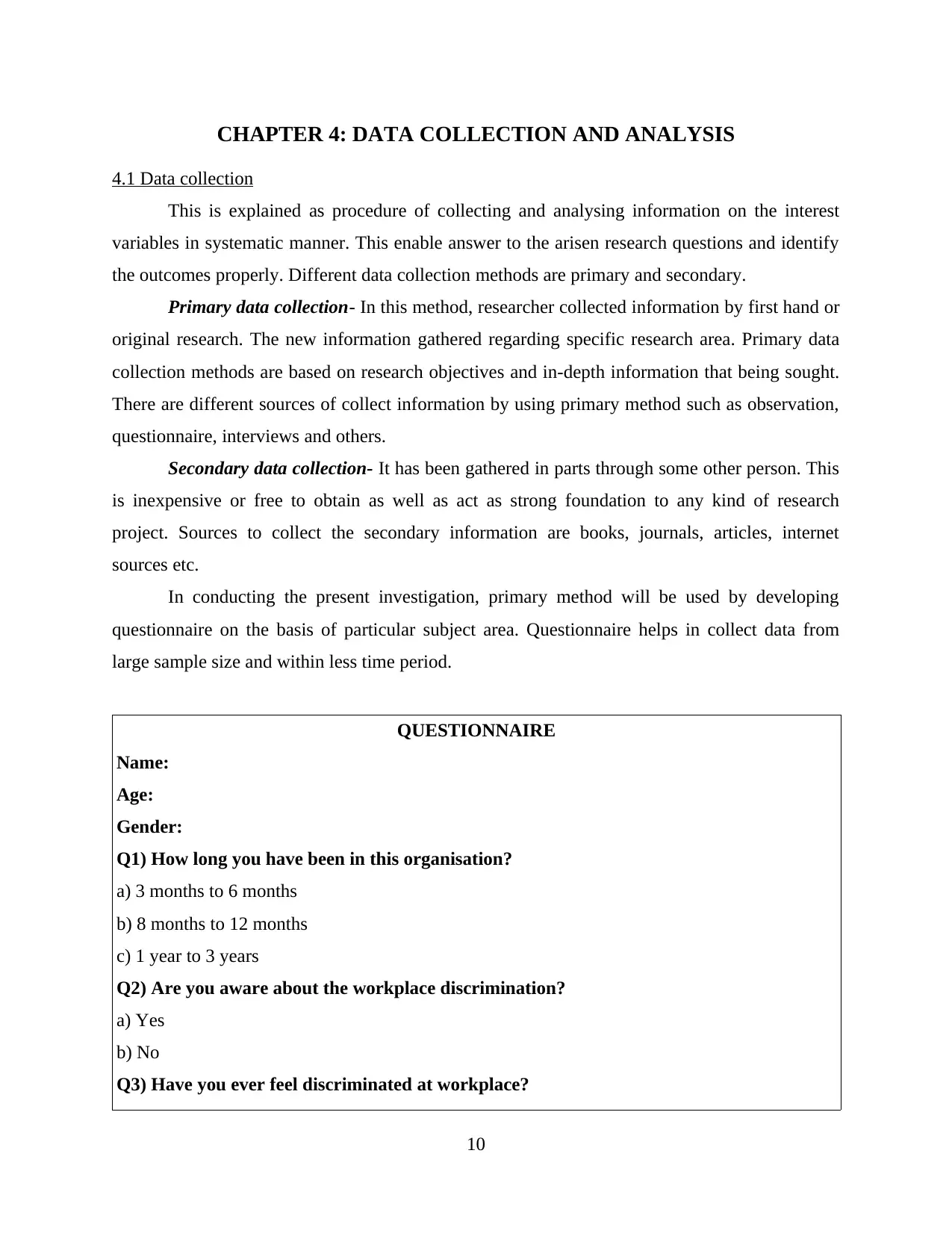
CHAPTER 4: DATA COLLECTION AND ANALYSIS
4.1 Data collection
This is explained as procedure of collecting and analysing information on the interest
variables in systematic manner. This enable answer to the arisen research questions and identify
the outcomes properly. Different data collection methods are primary and secondary.
Primary data collection- In this method, researcher collected information by first hand or
original research. The new information gathered regarding specific research area. Primary data
collection methods are based on research objectives and in-depth information that being sought.
There are different sources of collect information by using primary method such as observation,
questionnaire, interviews and others.
Secondary data collection- It has been gathered in parts through some other person. This
is inexpensive or free to obtain as well as act as strong foundation to any kind of research
project. Sources to collect the secondary information are books, journals, articles, internet
sources etc.
In conducting the present investigation, primary method will be used by developing
questionnaire on the basis of particular subject area. Questionnaire helps in collect data from
large sample size and within less time period.
QUESTIONNAIRE
Name:
Age:
Gender:
Q1) How long you have been in this organisation?
a) 3 months to 6 months
b) 8 months to 12 months
c) 1 year to 3 years
Q2) Are you aware about the workplace discrimination?
a) Yes
b) No
Q3) Have you ever feel discriminated at workplace?
10
4.1 Data collection
This is explained as procedure of collecting and analysing information on the interest
variables in systematic manner. This enable answer to the arisen research questions and identify
the outcomes properly. Different data collection methods are primary and secondary.
Primary data collection- In this method, researcher collected information by first hand or
original research. The new information gathered regarding specific research area. Primary data
collection methods are based on research objectives and in-depth information that being sought.
There are different sources of collect information by using primary method such as observation,
questionnaire, interviews and others.
Secondary data collection- It has been gathered in parts through some other person. This
is inexpensive or free to obtain as well as act as strong foundation to any kind of research
project. Sources to collect the secondary information are books, journals, articles, internet
sources etc.
In conducting the present investigation, primary method will be used by developing
questionnaire on the basis of particular subject area. Questionnaire helps in collect data from
large sample size and within less time period.
QUESTIONNAIRE
Name:
Age:
Gender:
Q1) How long you have been in this organisation?
a) 3 months to 6 months
b) 8 months to 12 months
c) 1 year to 3 years
Q2) Are you aware about the workplace discrimination?
a) Yes
b) No
Q3) Have you ever feel discriminated at workplace?
10
⊘ This is a preview!⊘
Do you want full access?
Subscribe today to unlock all pages.

Trusted by 1+ million students worldwide
1 out of 29
Related Documents
Your All-in-One AI-Powered Toolkit for Academic Success.
+13062052269
info@desklib.com
Available 24*7 on WhatsApp / Email
![[object Object]](/_next/static/media/star-bottom.7253800d.svg)
Unlock your academic potential
Copyright © 2020–2025 A2Z Services. All Rights Reserved. Developed and managed by ZUCOL.





